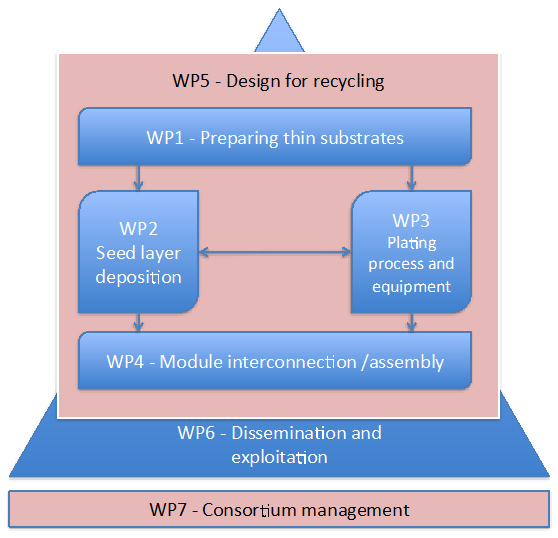CU-PV Project - Description
Objectives
- Make high-efficiency back-contact PV modules based on very thin silicon wafers, to reduce the silicon consumption per energy output by 50% and the energy payback time of the system by 30%
- Demonstrate the application of inkjet seeding and electroplating on high-efficiency solar cells, to reduce the silver consumption by a factor 100
- Strongly reduce the use of lead in cell fabrication and omit the use of lead in PV module fabrication
- Demonstrate design-for-recycling in PV module technology
Description
CU-PV will develop new metallisation methods based on inkjetting of Ag, Ni, Cu seed layers that are plated afterwards with Ni, Cu, which result in an at least 99% reduction of Ag consumption, and enable replacement of silver. Because inkjet and plating exert less stress on a wafer than conventional screen printing metallisation, these methods also enable the use of thinner wafers.
Back-contact solar cell design will allow for thin wafers and high efficiencies, resulting in 50% Si and about 30% PV system energy consumption reductions. The module assembly and interconnection of cells will be optimised for the new cell metallisation. Back-contact interconnection will allow for completely abandoning the use of lead, and will be designed, developed, and tested for recycling. In particular, the project will develop and demonstrate alternatives to current PV module recycling.
Project structure

Expected impact
The CU-PV project will demonstrate the technologies for more sustainable consumption and production patterns in silicon PV technology, reducing pressure on primary raw materials, reducing pollution, and fostering the use of secondary raw materials.
- Reduce depletion of silver reserves
The world Ag reserves are around 530,000 tons and the world primary Ag production per year is around 23,800 tons . The consumption of Ag in screen-printed solar cells of roughly 0.05-0.1 grams/Wp is clearly unsustainable in relation to typical European and national targets of 20% renewable energy in 2020, and 80% or more renewable energy in 2050, in which PV plays a major role. For example, if all electricity in Germany would be produced by PV made by present technology, it would consume 50,000-100,000 tons of Ag. CU-PV aims to reduce silver consumption per Wp by a factor 100. - Improve recycling
Designing-for-recycling will strongly reduce the need for energy, aggressive chemicals, and costly labor in the recycling process, reduce the energy required to recycle the component materials, and allow materials to be recycled with higher purity, into higher quality secondary products and into new PV modules. - Improve carbon footprint
Presently the PV industry uses about 6 grams/Wp of high-purity silicon. Including crystallisation for wafer production, the energy to produce this Si is about 1 kWh. This results in about 15 Mton CO2 emission for the present annual production of 30 GWp PV modules. CU-PV will halve the CO2 emission per Wp. - Reducing the use of lead in metallisation and avoiding the use of lead in module interconnection
Lead is presently used in soldered module interconnection, which is unacceptable on the longer term. The use of lead in solar cell metallisation must at least be strongly reduced. CU-PV will demonstrate lead-free high efficiency PV module interconnection.
